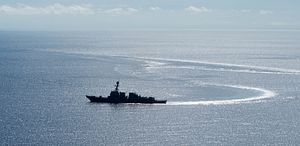President Donald Trump’s top national security official is floating an ambitious plan to refit the U.S. Navy’s venerable Arleigh Burke-class destroyers, at this point perhaps the most successful large warship class in naval history, with hypersonic missiles. As reported by David Larter, National Security Advisor Robert O’Brien said this week that an array of ships across the fleet will be upgraded to operate hypersonic missiles, starting with the Virginia-class nuclear attack submarines and continuing to the Zumwalt-class destroyers and then the Arleigh Burke fleet. This last has the opportunity to massively increase the lethality of the U.S. Navy’s surface fleet, offering a critical edge in the Pacific.
As Joseph Trevithick points out, the existing VLS containers on the Burkes are too small by far to accommodate the Conventional Prompt Strike vehicle. Trevithick suggests that O’Brien may have left open the option of equipping the Burkes with a smaller system to be developed in the future, something which his timeline would seem to allow. By contrast, the Zumwalts would require considerable modification, but are large enough that they have space to spare. Of course, updating the entirety of the Arleigh Burke class would be an enormously expensive undertaking. The oldest ships in the class entered service nearly 30 years ago, and although the ships have been regularly upgraded, altering them to operate a boost glide hypersonic vehicle would require significant, expensive modification. The lack of detail in O’Brien’s plan leaves open a lot of room for clarification, including the possibility that only new and recently constructed members of the class will receive the necessary refit.
It is not difficult to understand why O’Brien would have an interest in upgrading the DDG-51 force. Equipping Arleigh Burke destroyers with boost glide weapons would significantly extend their range and their lethality against surface targets, both at sea and on land. It would immeasurably complicate the problem of defending against U.S. attacks, which could come rapidly and from multiple vectors. Finally, it would more than match the Russian Navy’s achievement in equipping its surface fleet with the Zircon hypersonic missile, thus demonstrating that U.S. military technology remains on the cutting edge.
Of course, it’s also worth thinking about what the proliferation of boost glide vehicles across an array of maritime platforms might do to the prospects for crisis stability. The fear that a huge number of destroyers and submarines could strike China with virtual impunity from positions around the world might dissuade Beijing from aggression, but could also put an enormous strain on the cognitive ability of Chinese leaders to respond rationally to the unfolding of a militarized crisis. But as China has already conducted extensive work of its own on hypersonic weapons, it does not seem to make much sense for the U.S. to partake of unilateral self-restraint.
































